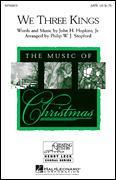Search Results for: “we three kings”
Loading...
We Three Kings Of Orient Are View 317 Products
We Three Kings View 28 Products
We Three Kings View 16 Products
We Three Kings Of Orient Are View 12 Products
See The Star! View 11 Products
We Three Kings Of Orient Are View 6 Products
We Three Kings (John Hopkins, Jr.) View 3 Products
We Three Kings/What Child Is This View 2 Products
We Three Kings (Weiser) View 1 Product
We Three Kings (Arr: Lorie Line) View 1 Product
Caravan On The Three Kings We Three Kings View 1 Product
We Three Kings/Good Christian Men Rejoice View 1 Product
We Three Kings/Carol Of The Bells View 1 Product
We Three Kings Of Orient Are (J.h. Hopkins) View 1 Product
We Three Kings Of Orient Are (Alex Shealy) View 1 Product
We Three Kings Of Orient Are Hopkins, John Henry View 1 Product
Paraphrase On We Three Kings Of Orient Are View 1 Product
We Three Kings Of Orient Are Hopkins, John Henry Jr. View 1 Product
Star Of Christmas Medley (It Came Upon, There's A Song, We Three Kings View 1 Product
